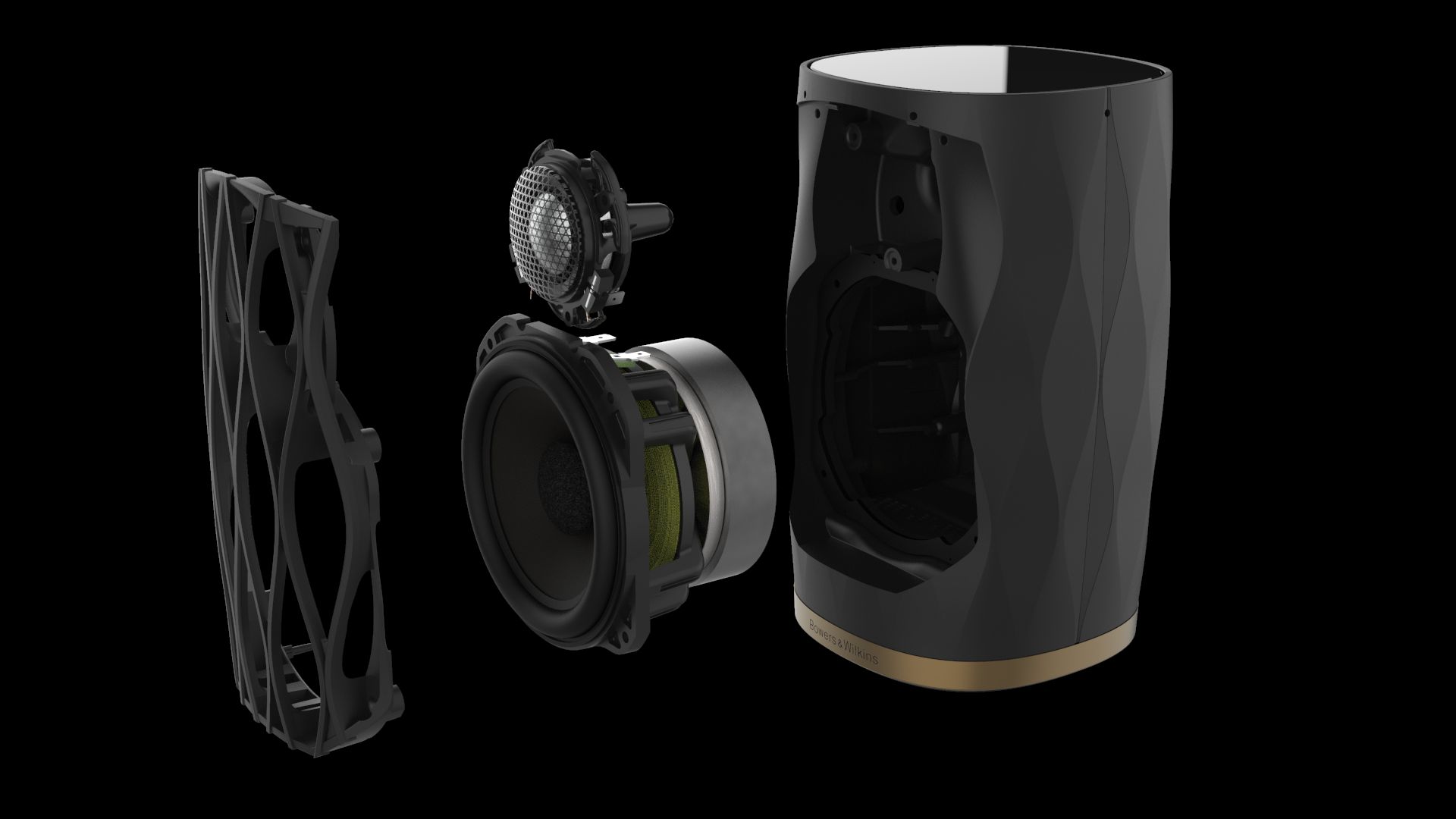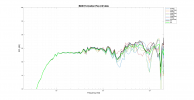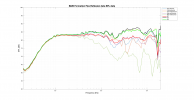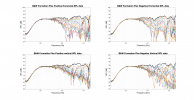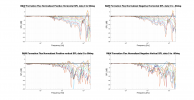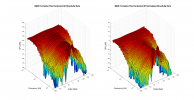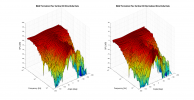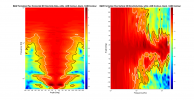This is a review and detailed measurements of the Bowers & Wilkins Formation Flex lifestyle speaker. It is on kind loan from a member and costs US $499.

The form factor is what we expect these days but the B&W unit is heavier than others I have tested. And that metal ring with their name gives it some style. There is some kind of grid pattern behind the thin fabric as you can barely tell from the photo.
Main connectivity is through Wifi although Ethernet is also provided:

The interface is typical of these speakers with touch sensitive "buttons" on top for power/status, play and volume up and down.
Bringing the speaker to life was a nightmare as it always seems to be the case with these speakers. Manual says to down the app but doesn't give the exact name -- again a common mistake. I found it in the app store and installed it. I then went to look for it in my Android app folder but could not see anything starting with "B." Come to find out it installs as "Music | Bowers and Wilkins." I get why they do this but sure screws up discoverability.
Once there, the app at first recognized the device quickly which I was happy to see. It then tells me to touch the power button which I thought I did. But the app quickly forgot about the speaker and would no longer see it. Adding to this is the fact that there is parallax error and you can ever be sure if you touched the darn button. Or what its myriad of blinking or color sequence means. I restarted the app half a dozen times but it would not see the unit. I think I even power cycled the speaker and it still did not work. I finally pushed the reset button and this time it all worked to the end. What a nightmare.
Why on earth don't this companies put a proper display on top of the speaker to inform the user what is happening? Or at least like Alexa speaker from Amazon have some voice responses giving some feedback? It is not like this speaker is cheap at $500 and can't afford $10 worth of parts. Why or why I have to guess what those fade in an out of the indicator light mean anything??? Style over function it is....
Measurements that you are about to see were performed using the Klippel Near-field Scanner (NFS). This is a robotic measurement system that analyzes the speaker all around and is able (using advanced mathematics and dual scan) to subtract room reflections (so where I measure it doesn't matter). It also measures the speaker at close distance ("near-field") which sharply reduces the impact of room noise. Both of these factors enable testing in ordinary rooms yet results that can be more accurate than an anechoic chamber. In a nutshell, the measurements show the actual sound coming out of the speaker independent of the room.
Measurements are compliant with latest speaker research into what can predict the speaker preference and is standardized in CEA/CTA-2034 ANSI specifications. Likewise listening tests are performed per research that shows mono listening is much more revealing of differences between speakers than stereo or multichannel.
Reference axis was the tweeter center as best as I could guess through the grill. Measurement temperature was about 62 degrees F (17 degrees C).
B&W Formation Flex Speaker Measurements
Let's start with our usual "spinorama" graph:

I must say, I expected the response to be horrible but it is not. Instead, we have some shelving in two regions. I have to think they have done this for some reason. Then again we have a dip there and I can't explain why they would want that. As noted, directivity is decent so EQ should work even though such is unlikely to be used by the typical customer.
Early window reflections confirms the same:

Putting the two together we get this kind of response if you used the speaker in a typical stereo room:

There is no attempt to control directivity:


I can imagine you want very wide directivity for such a speaker. So not controlling it is good in early part of the spectrum, but not so good in higher frequencies.
Vertical dispersion is not as important in home speakers but here, I would think it is important given that people put this speaker some place and move around/stand up and down to hear it. Sadly the response is poor in this regard:

When I powered on the unit, i had it on the floor and when I played the first track, I thought it was the worst sound I had heard! So audibility is there for sure.
I was impressed by low distortion of this powered speaker:


Some of the high cost you play clearly has gone toward better amplification.
Measuring these speakers is a pain since the analyzer can't control the unit. So I don't have full suite of measurements for you. But here is the step response:

B&W Formation Flex Listening Tests
For my listening tests, I treated the speaker as a near-field monitor. I placed it on top of my equipment rack with the front of it aligned with the front edge of my rack and listened at about 4 feet/1+ meter. Listening angle was slightly above tweeter axis.
As is typical of speakers with elevated highs, first impression is of a sound with high resolution and good quality especially on female vocals which is where I start. Let that sink in though and in a few minutes you realize it is too bright. The point is brought home when you apply EQ to lower that high frequency response and then AB. My preference at least is for less brightness. So EQ came out:

The right two filters should be self explanatory. The one in bass I experimented with. With most tracks the increased warmth and more bass was welcome. On some others, likely due to room modes, it sounded boomy. So you may want to try that and see what your taste is.
Oh, please ignore the "RME ASIO" indicator. I just brought up the EQ to take a snapshot of the UI. Testing was done using Airplay to Formation Flex.
Speaker can get pretty loud as distortion measurements indicate. Pushed to max limit (volume 100), you get soft limiting, reduction of volume on deep bass notes but even then, it is not annoying.
What was annoying was this gargling/low level noise I was hearing in a few quiet tracks. I thought it was data loss related so connected Ethernet cable but made no difference. It was like a delayed static of the actual content of the track. Very odd but super annoying.
Conclusions
I can partially see where the more money has gone as far as designing this speaker. At the end though, it doesn't rise up much above average smart speaker of this type and in my view, doesn't at all justify its $500 cost. Combine this with poor usability and static/noise I was hear and you have me on the unhappy side of the fence here. As such, I can't recommend Bowers & Wilkins Formation Flex.
-----------
As always, questions, comments, recommendations, etc. are welcome.
Any donations are much appreciated using: https://www.audiosciencereview.com/forum/index.php?threads/how-to-support-audio-science-review.8150/
The form factor is what we expect these days but the B&W unit is heavier than others I have tested. And that metal ring with their name gives it some style. There is some kind of grid pattern behind the thin fabric as you can barely tell from the photo.
Main connectivity is through Wifi although Ethernet is also provided:
The interface is typical of these speakers with touch sensitive "buttons" on top for power/status, play and volume up and down.
Bringing the speaker to life was a nightmare as it always seems to be the case with these speakers. Manual says to down the app but doesn't give the exact name -- again a common mistake. I found it in the app store and installed it. I then went to look for it in my Android app folder but could not see anything starting with "B." Come to find out it installs as "Music | Bowers and Wilkins." I get why they do this but sure screws up discoverability.
Once there, the app at first recognized the device quickly which I was happy to see. It then tells me to touch the power button which I thought I did. But the app quickly forgot about the speaker and would no longer see it. Adding to this is the fact that there is parallax error and you can ever be sure if you touched the darn button. Or what its myriad of blinking or color sequence means. I restarted the app half a dozen times but it would not see the unit. I think I even power cycled the speaker and it still did not work. I finally pushed the reset button and this time it all worked to the end. What a nightmare.
Why on earth don't this companies put a proper display on top of the speaker to inform the user what is happening? Or at least like Alexa speaker from Amazon have some voice responses giving some feedback? It is not like this speaker is cheap at $500 and can't afford $10 worth of parts. Why or why I have to guess what those fade in an out of the indicator light mean anything??? Style over function it is....
Measurements that you are about to see were performed using the Klippel Near-field Scanner (NFS). This is a robotic measurement system that analyzes the speaker all around and is able (using advanced mathematics and dual scan) to subtract room reflections (so where I measure it doesn't matter). It also measures the speaker at close distance ("near-field") which sharply reduces the impact of room noise. Both of these factors enable testing in ordinary rooms yet results that can be more accurate than an anechoic chamber. In a nutshell, the measurements show the actual sound coming out of the speaker independent of the room.
Measurements are compliant with latest speaker research into what can predict the speaker preference and is standardized in CEA/CTA-2034 ANSI specifications. Likewise listening tests are performed per research that shows mono listening is much more revealing of differences between speakers than stereo or multichannel.
Reference axis was the tweeter center as best as I could guess through the grill. Measurement temperature was about 62 degrees F (17 degrees C).
B&W Formation Flex Speaker Measurements
Let's start with our usual "spinorama" graph:
I must say, I expected the response to be horrible but it is not. Instead, we have some shelving in two regions. I have to think they have done this for some reason. Then again we have a dip there and I can't explain why they would want that. As noted, directivity is decent so EQ should work even though such is unlikely to be used by the typical customer.
Early window reflections confirms the same:
Putting the two together we get this kind of response if you used the speaker in a typical stereo room:
There is no attempt to control directivity:
I can imagine you want very wide directivity for such a speaker. So not controlling it is good in early part of the spectrum, but not so good in higher frequencies.
Vertical dispersion is not as important in home speakers but here, I would think it is important given that people put this speaker some place and move around/stand up and down to hear it. Sadly the response is poor in this regard:
When I powered on the unit, i had it on the floor and when I played the first track, I thought it was the worst sound I had heard! So audibility is there for sure.
I was impressed by low distortion of this powered speaker:
Some of the high cost you play clearly has gone toward better amplification.
Measuring these speakers is a pain since the analyzer can't control the unit. So I don't have full suite of measurements for you. But here is the step response:
B&W Formation Flex Listening Tests
For my listening tests, I treated the speaker as a near-field monitor. I placed it on top of my equipment rack with the front of it aligned with the front edge of my rack and listened at about 4 feet/1+ meter. Listening angle was slightly above tweeter axis.
As is typical of speakers with elevated highs, first impression is of a sound with high resolution and good quality especially on female vocals which is where I start. Let that sink in though and in a few minutes you realize it is too bright. The point is brought home when you apply EQ to lower that high frequency response and then AB. My preference at least is for less brightness. So EQ came out:
The right two filters should be self explanatory. The one in bass I experimented with. With most tracks the increased warmth and more bass was welcome. On some others, likely due to room modes, it sounded boomy. So you may want to try that and see what your taste is.
Oh, please ignore the "RME ASIO" indicator. I just brought up the EQ to take a snapshot of the UI. Testing was done using Airplay to Formation Flex.
Speaker can get pretty loud as distortion measurements indicate. Pushed to max limit (volume 100), you get soft limiting, reduction of volume on deep bass notes but even then, it is not annoying.
What was annoying was this gargling/low level noise I was hearing in a few quiet tracks. I thought it was data loss related so connected Ethernet cable but made no difference. It was like a delayed static of the actual content of the track. Very odd but super annoying.
Conclusions
I can partially see where the more money has gone as far as designing this speaker. At the end though, it doesn't rise up much above average smart speaker of this type and in my view, doesn't at all justify its $500 cost. Combine this with poor usability and static/noise I was hear and you have me on the unhappy side of the fence here. As such, I can't recommend Bowers & Wilkins Formation Flex.
-----------
As always, questions, comments, recommendations, etc. are welcome.
Any donations are much appreciated using: https://www.audiosciencereview.com/forum/index.php?threads/how-to-support-audio-science-review.8150/
